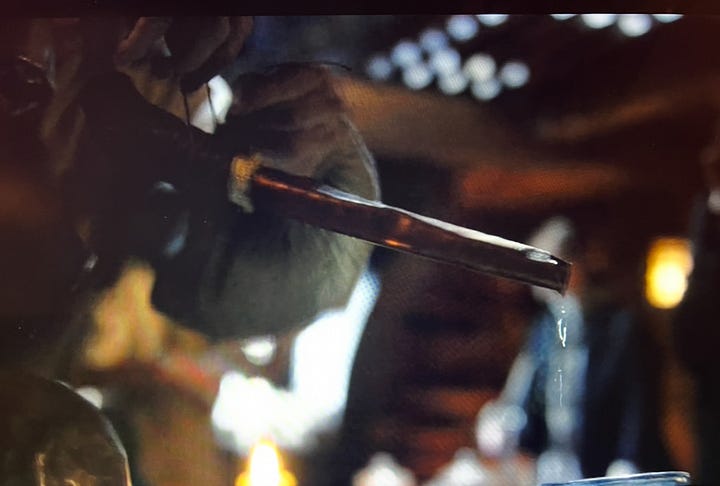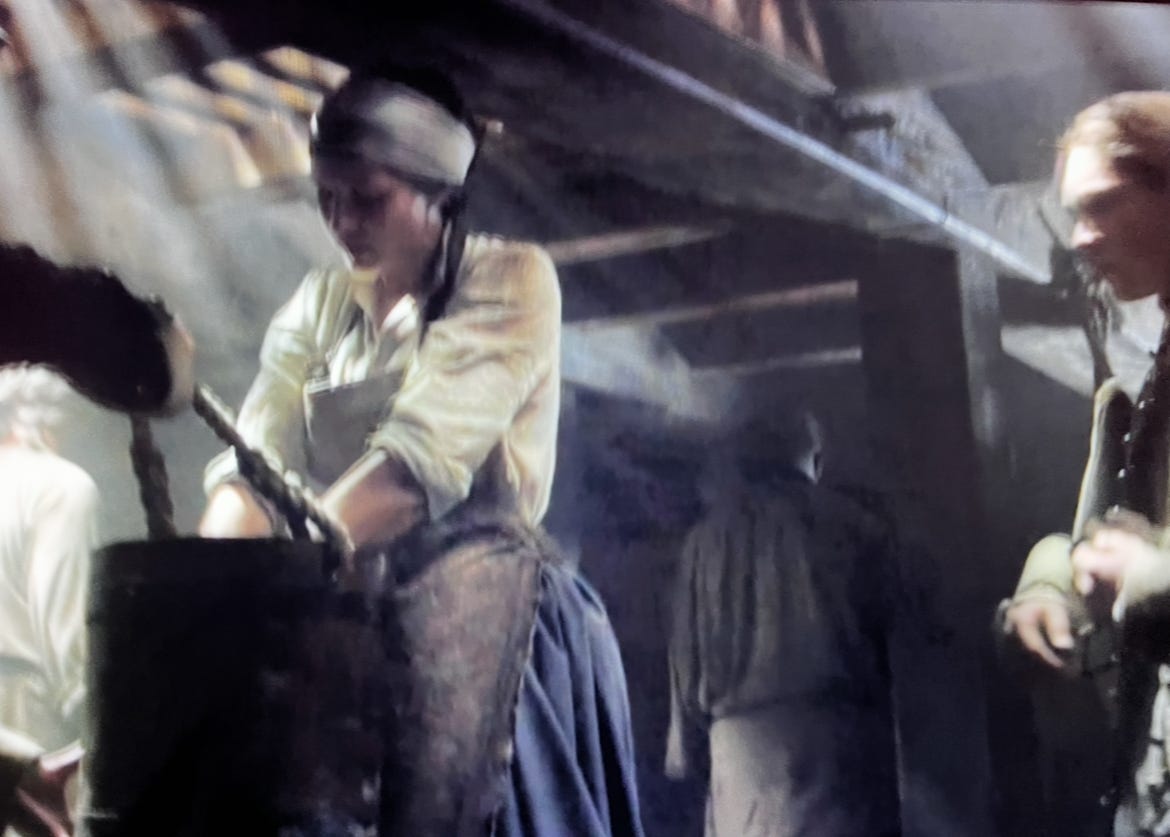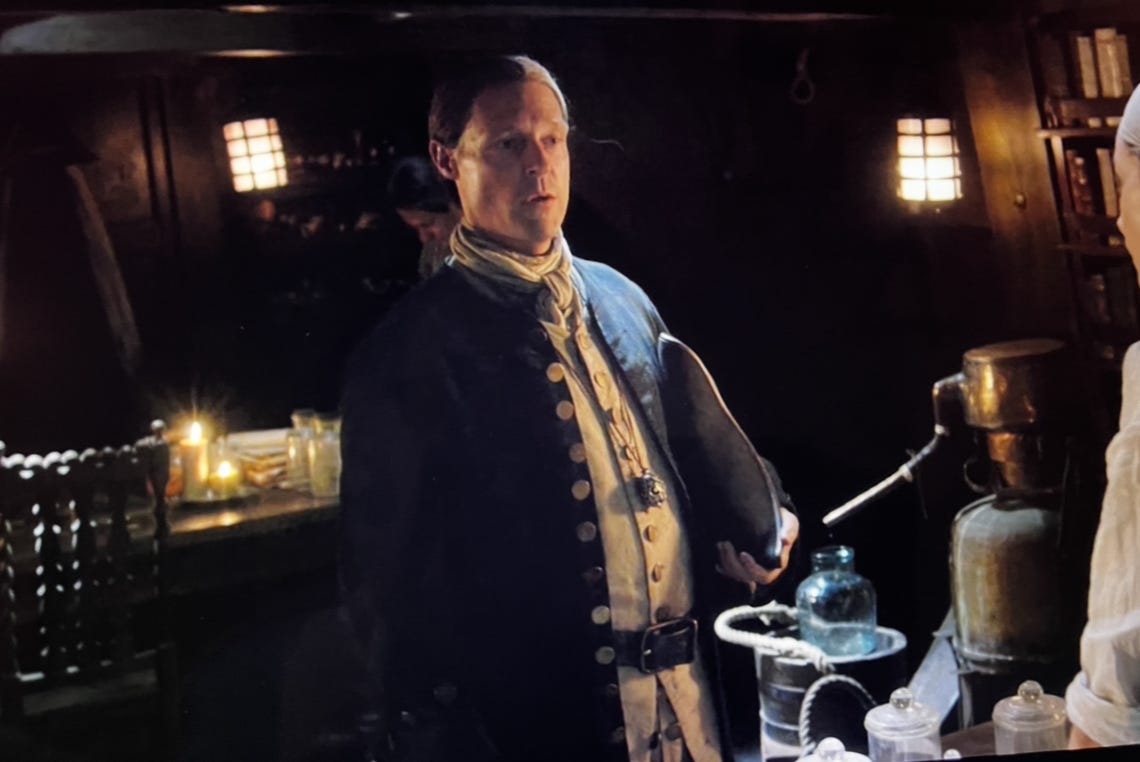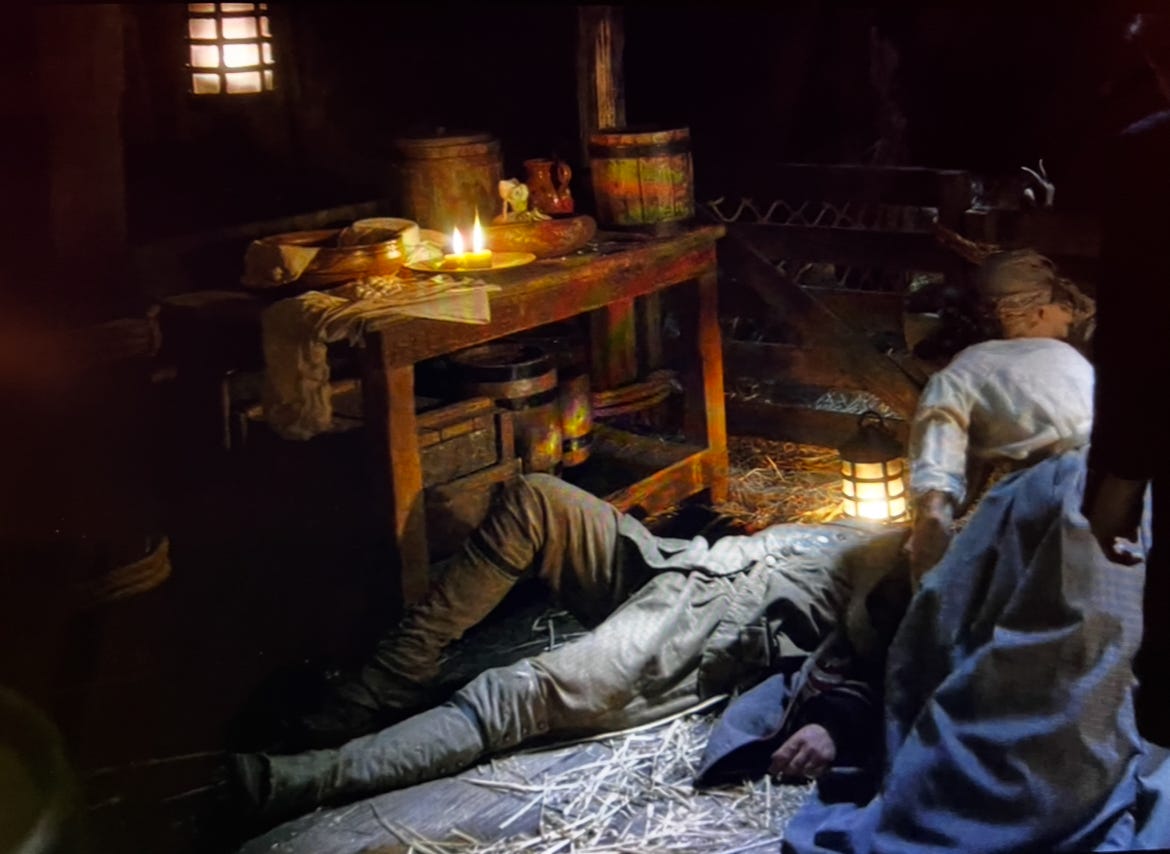NOTE: These discussions presume you have seen the episode listed above. If you haven’t seen this episode, be forewarned: there be spoilers here!
In episode 310, Heaven and Earth, Claire has been lifted from Jamie and the Artemis mid-voyage and pressed into service as ship’s surgeon aboard His Majesty’s Ship Porpoise to handle an outbreak of ‘ship’s fever’, about which I posted previously.
Credit: STARZ Outlander Ep310 - Heaven and Earth. Claire dips her hands in grog below deck on the Porpoise.
In an effort to limit spread of the infectious malady, Claire is having all the sailors sterilize hands and surfaces with grog.
Credit: STARZ Outlander Ep310 - Heaven and Earth. Elias Pound tells Claire they have men on board who will know how to make a still if that would help.
Her charming, intelligent young aide de camp, Elias Pound, queries Claire whether it might be helpful if they “had someone as knew how to distill rum to make pure alcohol” and volunteered that they had a pair of prisoners on board whose previous illegal whisky-making activities suggest they might know how to make a still.
Credit: STARZ Outlander Ep310 - Heaven and Earth. Claire discussing providing raw materials for the distillation with the Purser aboard the Porpoise. The still is visible at the right.
Claire is delighted and tells them to get right on it, which they do in short order (with materials cobbled together from the galley — copper pots and kettles, it looks like — although I don’t know where they got the copper tubing out in the middle of the ocean.


Credit: STARZ Outlander Ep310 - Heaven and Earth. Close ups of the tubing on the still.
Perhaps they heated and bent a sheet of copper pounded from a pot around something. Who knows? Anyway, we’ll let that go.)
To keep the men from drinking the high-octane product, they set a guard – one Mr. Johansen, Annekje the goat lady’s husband.
Credit: STARZ Outlander Ep310 - Heaven and Earth. Claire kneels beside the unconscious Mr. Johansen.
Claire is summoned when Annekje finds her husband unresponsive in the still room. ‘Not breathing!’ she repeats anxiously.
Credit: STARZ Outlander Ep310 - Heaven and Earth. Claire listens for Johansen’s breathing and counts his carotid pulse.
Claire examines the man, voicing her findings aloud for us as she goes: He’s breathing but very slowly. His heart rate is very slow. He’s got no fever, in fact, he’s cool to the touch. It’s not typhoid.
Credit: STARZ Outlander Ep310 - Heaven and Earth. Claire checks for fever.
She pulls up an eyelid; he’s not responsive.
Credit: STARZ Outlander Ep310 - Heaven and Earth. The glass jar containing some ethanol left after Johansen drank himself into a stupor on it.
She’s at sea (sad pun intended) as to cause of his condition until a lurch of the ship sends a canning jar still containing a bit of clear liquid clattering across the floor. She sniffs the contents – alcohol! Their precious alcohol!
Credit: STARZ Outlander Ep310 - Heaven and Earth. Claire turns Johansen on his left side.
Fuming mad, she rolls the man to his side and pronounces to his wife that he’s not going to die, that he’s simply nearly drunk himself to death on the alcohol that they need to battle the spread of the fever, but that he’ll recover.
(Claire said it much more colorfully, apologizing afterward for offending young Pound’s ears; he told her he’d heard that kind of language plenty of times but never from a gentlewoman. She replies, not for the first time, that she’s not a gentlewoman.)
She tells Annekje and Pound to keep him turned on his side so he won’t choke if he vomits and to watch his breathing and stay with him. Then she heads back to deal with the spreading illness.
Was Claire correct in her interpretation of findings? In her instructions for his care? Let’s first look at the intoxicating substance itself.
What is Grog?
In the 18th Century, British sailors were allotted a daily ration of ‘grog’ which was a dilution of 100 Proof Caribbean Rum with water. Each man was given what amounted to about a half pint (an 8-ounce cup) of rum per day diluted with an imperial quart of water, half issued in the forenoon, and the balance after the work day was complete.
The 100 proof mother liquor – rum – has a strength of 58% ABV (alcohol by volume), so, if I’m doing the math correctly, diluted 4 to 1 the grog would have had an ABV of 11.6%. (If I’m wrong, I’m sure someone will let me know.) Stronger than a beer, that’s about like an unfortified wine, but they got a quart of it per day.
It’s rum that Mr. Pound asks Claire about distilling into pure alcohol, but I’m unsure from her response about putting the men on half rations of grog whether they were using the rum or the grog for their starting batch. We know they put the men on half rations of grog and if that’s what they use, they begin their distillation with a beverage that is 11.6% alcohol (23 proof).
In order to purify it to a higher ABV the men will need to heat the grog and capture the vapor that comes off in a column or a pot still, cool it back to a liquid, and collect it. They may need to do this multiple times to reach a ‘nearly pure ethanol’ at 90% ABV if starting with grog. It wouldn’t take as many runs if starting with rum.
Ideally when distilling spirits, you’d have a thermometer at hand for safety, but I seriously doubt the pressed (or convicted) moonshiners had one with them on the Porpoise.
As an aside, thermometers did exist at the time. In the late 16th and early 17th centuries, Galileo Galilei supposedly created something like a thermometer, an instrument called a thermoscope that used the expansion and contraction of air to indicate temperature changes. In 1654, Ferdinand II de' Medici, Grand Duke of Tuscany, is said to have developed the first sealed-glass thermometer, and in 1714 Daniel Fahrenheit developed the first mercury thermometer with a standardized scale, a half-century before the time period of Ep310. Having one would have made the job of safe distilling easier by far but it’s doubtful they had one.
The purpose of these subsequent distillation runs is to separate out the starting batch into several fractions: the foreshot, the heads, the heart, and the tails, each of which comes off (vaporizes) at a progressively higher temperature, so having the ability to measure temperature makes the job less fraught with risk.
The main risk in distilling liquor lies in contaminating the ‘drinking spirit’ with toxic forms of alcohol—such as methanol or wood alcohol as it’s known—that vaporize at a lower point than ethanol (drinking alcohol) or water.
Methanol comes off first, at about 148.5F, so this earliest distillate (the foreshot) should always be discarded as it can contain not only methanol but even acetone (fingernail polish remover you’d know it as nowadays). Wood alcohol poisoning (moonshine poisoning) is an urgent medical emergency. It really can make you go blind, if it doesn’t go ahead and kill you outright. So you always toss the foreshots and keep on heating.
Next off are the heads, which may contain unwanted flavor profiles and contaminants. Again usually discarded, unless there is a specific flavor compound you’re wanting to keep in the spirit. Then you’d want to know the temperature at which that compound volatilized to capture it. (And you thought you’d never need that high school chemistry!)
The heart – the ethanol or drinking spirit – comes off next at about 173F; this is the product you’re after. Once you’re near boiling, at 212F, it’s water you’re driving off – the tails – and you’d discard that as well.
The men running the still on the Porpoise didn’t have quite as much to worry about regarding contaminants and toxins as your average moonshiner. The rum (or the grog made from it) would have gone through a number of distillations before it became 100 Proof rum, so the risk the grog might be contaminated with methanol or acetone isn’t so great. And this may be the rationale for Claire’s somewhat dismissive attitude toward the seriously drunken Mr. Johansen. It’s not likely methanol poisoning. Though there’s still plenty of danger possible for him with ethanol as tragic deaths in college fraternity parties make clear too often.
What Is Acute Alcohol Poisoning?
Even putting the methanol risk aside, intake of a sufficient amount of essentially pure ethanol in a short space of time can prove fatal, as it overwhelms the body’s ability to metabolize and detoxify it. Make no mistake, alcohol is a poison, albeit a delicious one. And the toxic metabolites from its breakdown build up in the bloodstream, creating a medical emergency that depresses breathing, heart rate, the gag reflex, and can even lead to coma and death.
After it’s been drunk, ethanol is rapidly absorbed into the bloodstream from the stomach (about 25%) and the small intestine (about 75%) and distributed throughout the body including the brain (where it causes the buzz or the stupor) and the liver (where it is primarlydetoxified.)
The detoxification of ethanol involves two major enzymatic phases. The first converts ethanol to a highly toxic and carcinogenic compound called acetaldehyde via an enzyme called Alcohol Dehydrogenase (ADH).
The second step converts the actealdehyde to acetic acid (the main acid in vinegar) via an enzyme called aldehyde dehydrogenase (ALDH). This step is crucial and needs to happen rapidly and efficiently because acetaldehyde is highly reactive and responsible for many of the negative effects of alcohol, such as hangover symptoms and tissue damage.
The acetic acid (or acetate) is further metabolized, mainly in tissues outside the liver, into carbon dioxide and water, which are then eliminated from the body via sweat, urine, and breath.
This is what is happening in this scene with Johansen, though a sailor used to drinking a cup of 100 proof rum diluted with water throughout the day, day in and day out, probably has a pretty revved up ability to detoxify alcohol and plenty of aldehyde dehydrogenase (the enzyme that does it) on board at all times. That, too, may have figured into Claire’s calculus about how concerned or not to be.
Claire correctly handled the most immediate danger to the man—aspiration of vomit into the lungs. Because blood alcohol at this level will have depressed his gag reflex, if he should vomit (a likely occurrence with alcohol overconsumption) the proximity of the route from stomach to mouth and the opening from mouth to lungs (via larynx and trachea) will mean stomach contents that flow into the back of the throat can be inhaled into the lungs (aspiration) with the next breath.
The gag reflex is triggered when something touches the back of the throat or base of the tongue, as vomit coming up from the stomach would do. This stimulus normally causes the pharynx to contract and propel the substance forward and out the mouth, protecting the airway entry. A weak or absent gag reflex is a major danger here, as many a dead rock star could attest were they able.
By properly turning him on his left side, Claire reduces the chance of his choking if he vomits. Positioning him on his left side with his head tilted forward (the recovery position, it’s called) lets gravity assist in directing any vomit forward toward the opening of the mouth rather than letting it pool in the back of the throat.
Why the left side?
Because the anatomic configuration of the main bronchial airways into the two lungs differs. The right lung is made of three lobes, each with its own bronchus leading off the trachea. The left lung has only two lobes, also each with a bronchus. But the trachea and the right main bronchus are more in direct line, making it easy for something in the trachea to flow straight into the right lung. Putting the right side of the body up changes all that. The bronchi on the left side enter the trachea at a more acute angle which makes it less likely food or stomach contents coming down the trachea will make it into the lung on that side. Not impossible, mind you, but less likely.
Claire also properly set someone to watch him, though what they’d do if he quit breathing or had a heart rhythm disturbance, or a seizure, other than calling for her to come again, I can’t imagine. And, for that matter, what she’d be able to do other than rescue breathing and chest compressions, which might or might not have worked. The CPR technique was developed in 1960 by Drs. William Kouwenhoven, Peter Safar, and James Jude, so Claire would have probably been taught how to do it in Boston by 1968.
She has no ability to pump his stomach, which might be done nowadays to reduce the alcohol load. (And of course today he’d get an IV line inserted to keep a vein open if needed for resuscitation, and he’d get fluids and supplemental oxygen.) In a person who is unconscious (and even in one semi-conscious), it wouldn’t be safe to induce him to vomit up the excess alcohol, lest she cause the very aspiration and choking she’s trying to prevent.
IMHO she did what she could do, and the rest was up to watching him through that critical time and Mr. Johansen’s ability to metabolize and detoxify the alcohol as quickly as possible.
In this scene, Johansen is displaying all the signs of severe alcohol poisoning, probably sporting a BAC (blood alcohol concentration) of 0.3% to 0.4%. By way of comparison, the legal limit of alcohol in the blood to be considered impaired when driving is 0.08% across most of America (much less than that in some countries with stricter laws). So Mr. Johansen was beyond being aff his heid drunk; he was well and rightly blootered.
At this level of intoxication, respiratory and cardiac arrest are distinctly possible. And should either have occurred, there would probably have been little Claire could have done about it. Fortunately for Mr. and Mrs. Johansen (and for Claire and Jamie as it turns out later in the storyline) tincture of time and his detoxifying ability proved enough.
Overall Medical Verity Score: I’ll give them an A for medical accuracy of the condition. He displayed and Claire recognized all the signs and symptoms of acute alcohol poisoning — slow respirations, hypothermia (skin cool and moist to the touch), slow heart rate, unresponsiveness. And she treated the problem correctly within the scope of what was available to her, which was little beyond positioning him to protect his airway and watching him.













You wrote, "The right lung is made of three lobes, each with its own bronchus leading off the trachea. The left lung has only two lobes, also each with a bronchus." I thought the LEFT lung had 3 lobes and the RIGHT lung only 2 lobes. But hey, I'm no expert! :-)